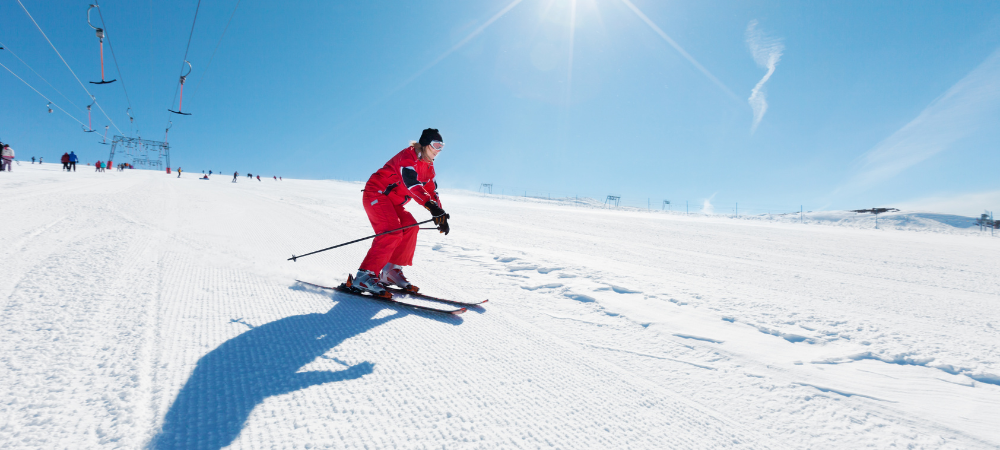As the leaves change colors and the air turns crisp, the excitement starts building for ski season. There’s something truly magical about gliding down snow-covered slopes, feeling the rush of cold air against your face and conquering challenging terrain. But to truly make the most of your time on the mountain, It’s important to get your body in shape with ski exercises.
Skiing and snowboarding demands more than just a love for the snow; it requires strength, endurance and agility. In this article, we’ll explore a range of workouts for skiing that can help you prep for the upcoming ski season. Whether you’re a seasoned skier or a newbie hitting the slopes for the first time, these exercises for skiing will get you ready to tackle the mountains. And don’t worry, if you don’t know where to start with skiing workouts, our Personal Trainers are here to help!
Why Is It Important to Prep for Ski Season?
Skiing and snowboarding are exhilarating winter sports that engage a variety of muscles in your body. To make those graceful turns and power down the slopes, you rely on a combination of strength, balance and coordination. Without proper preparation, you may find yourself fatigued, sore and at risk of injury. That’s why it’s crucial to target the specific muscle groups that skiing works.
What Muscles Does Skiing Work?
Before diving into the ski exercises, let’s understand which muscles are heavily involved in these winter sports:
-
Quadriceps
Your quads play a vital role in maintaining a strong, controlled stance while skiing. They help you maintain balance and absorb shocks as you navigate various terrains.
-
Hamstrings
These muscles are responsible for bending your knees and controlling your speed as you descend down the mountain. Strong hamstrings provide stability and prevent knee injuries.
-
Glutes
The gluteal muscles help power your movements and stabilize your hips. They are essential for generating the force needed for those quick turns and jumps.
-
Core
Your core muscles, including your abdominals and lower back, provide stability and balance as you twist and turn on the slopes. A strong core also protects your spine during falls.
-
Calves
These muscles are crucial for ankle flexibility and control, which is vital for maintaining a good skiing posture.
-
Hip Flexors
Skiing and snowboarding involves a lot of hip movement, making the hip flexors important for maintaining proper body alignment and controlling your skis.
Best Exercises For Skiing
Now that we know which muscles are involved in skiing, let’s delve into the best exercises to prepare for the ski season.
1. Squats
One of the most effective ski exercises to prepare for the season is the squatting. Squats target your quadriceps, hamstrings and glutes, making them stronger and more resilient. To perform a squat, stand with your feet shoulder-width apart, lower your body by bending your knees and hips, and then push back up to the starting position. You can make this harder by adding weight using a barbell and positioning it across your upper back, or by holding one dumbbell in each hand, allowing them to hang by your sides with your arms fully extended.. Repeat this movement for three sets of 15 reps each.
2. Leg Blasters
Leg blasters are a challenging but incredibly beneficial ski workout. They not only work your quads, hamstrings and glutes but also improve endurance. To do leg blasters, start with ten air squats, followed by ten alternating lunges, ten jumping lunges and ten jumping air squats. Repeat this cycle three times for a full leg-blasting workout.
3. Romanian Deadlifts
Romanian deadlifts target your hamstrings and lower back while also engaging your glutes and core. Hold a barbell or dumbbells in front of your thighs and, keeping your back straight, hinge at the hips to lower the weight until your back is parallel to the ground. Return to the starting position and repeat for three sets of 12 reps each.
4. Planks
Strengthening your core is essential for maintaining balance and stability on the slopes. Planks are a simple yet effective exercise for this. Begin in a push-up position with your palms on the ground and your body in a straight line from head to heels. Hold this position for 30 seconds to a minute, gradually increasing your time as you get stronger.
5. Wall Sits
Wall sits are an excellent way to target your quads and build endurance. Find a sturdy wall and lower your body into a sitting position with your thighs parallel to the ground. Hold this position for as long as you can, aiming to increase your time with each workout. Wall sits are a fantastic exercise for mimicking the sustained leg tension you’ll experience while skiing.
6. Box Jumps
Box jumps are perfect for enhancing explosive leg power and agility. Find a sturdy box or platform, stand in front of it, and then jump onto it with both feet. Step down and repeat for three sets of 10 reps. This exercise simulates the quick movements required to navigate moguls and jumps on the ski slopes.
7. Calf Raises
Strong calf muscles are essential for maintaining control over your skis and absorbing shocks. To perform calf raises, stand on the edge of a step or platform with your heels hanging off. Raise your heels as high as possible, then lower them below the step to stretch your calves. Repeat for three sets of 15 reps.
8. Hip Circles
Hip circles are an excellent exercise to improve hip mobility and warm up your hip joints. Stand with your feet shoulder-width apart and place your hands on your hips or a stable surface for balance if needed. Begin by gently rotating your hips in a clockwise direction, envisioning a circle with your hip joint. Start with small circles and gradually increase their size as your hips loosen up. Do 10-15 clockwise circles, then switch to counterclockwise circles for 10-15 repetitions. Perform 2-3 sets in each direction.
9. Lunging Hip Flexor Stretch
This stretch targets the hip flexors, quadriceps and groin muscles. Begin by positioning yourself in a lunge stance with your right foot forward and your left leg extended straight behind you. As you lower your hips, ensure that your right knee stays directly above your ankle. Next, gently tuck your pelvis under and slowly push your hips forward. This action will create a noticeable stretch in the front of your left hip, specifically targeting the hip flexor muscles. Hold this stretch for approximately 20-30 seconds to allow your muscles to relax and lengthen. Repeat with the other leg.
Benefits of Preparing with Ski Exercises
Now that we’ve covered some of the best exercises for skiing, let’s explore the benefits of incorporating them into your pre-season routine:
- Improved Performance: Strengthening the muscles used in skiing will boost your performance on the slopes. You’ll have better control over your movements and be able to tackle more challenging terrain with confidence.
- Reduced Risk of Injury: Strong muscles and a stable core can help protect you from common skiing injuries, such as knee ligament strains and back injuries.
- Increased Stamina: Skiing can be physically demanding, and pre-season training will enhance your endurance, allowing you to enjoy longer days on the mountain without getting fatigued.
- Better Balance: Ski exercises improve your balance and coordination, which are essential for navigating uneven terrain and maintaining control at high speeds.
- Faster Recovery: If you do happen to take a spill on the slopes, a well-prepared body will recover more quickly, minimizing downtime during your ski trip.
How Often Should You Train With Ski Exercises?
The frequency of training with ski exercises depends on your current fitness level, your goals and how close you are to the ski season. It’s essential to strike a balance between building strength, endurance and agility without overtraining. Here are some guidelines for the frequency of doing ski workouts:
-
Pre-Season (4-8 Weeks Before Ski Season):
- As the ski season approaches, training with ski-specific exercises 2-4 times per week can be highly beneficial.
- Focus on exercises that mimic skiing movements, such as squats, lunges, balance drills and core strengthening exercises.
- This pre-season phase is crucial for fine-tuning your skiing muscles and improving your skiing-specific fitness.
-
Peak Training Phase (2-4 Weeks Before Ski Season):
- During the final few weeks leading up to the ski season, you can further intensify your training, with a frequency of 4-6 times per week.
- Emphasize power, agility and explosive strength exercises to simulate the demands of skiing.
- Include sport-specific drills like box jumps, lateral movements and quick turns.
-
Tapering Phase (1-2 Weeks Before Ski Season):
- In the last 1-2 weeks before the ski season, reduce the frequency of intense training sessions to ensure you are well-rested and fully recovered.
- Focus on mobility, flexibility and light, low-impact exercises.
- Consider incorporating a Yoga Class or trying out our Assisted Stretch Program which is available at select EōS locations, so you can maintain flexibility and prevent stiffness.
Getting ready for ski season involves more than just waxing your skis and picking out your favorite gear. It requires preparing your body for the physical demands of the sport. By incorporating these ski exercises into your pre-season routine, you’ll strengthen the specific muscle groups essential for skiing, such as the quadriceps, hamstrings, glutes and core. Consulting with a Personal Trainer can help you create a personalized training plan that aligns with your ski fitness goals and ensures you’re on track to perform at your best when the ski season arrives.



